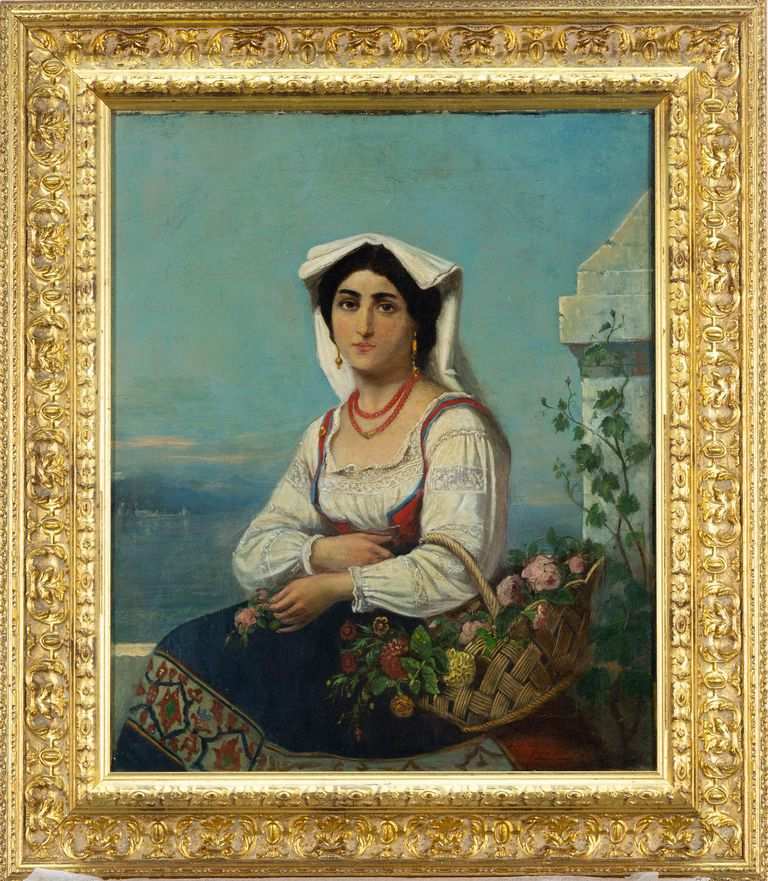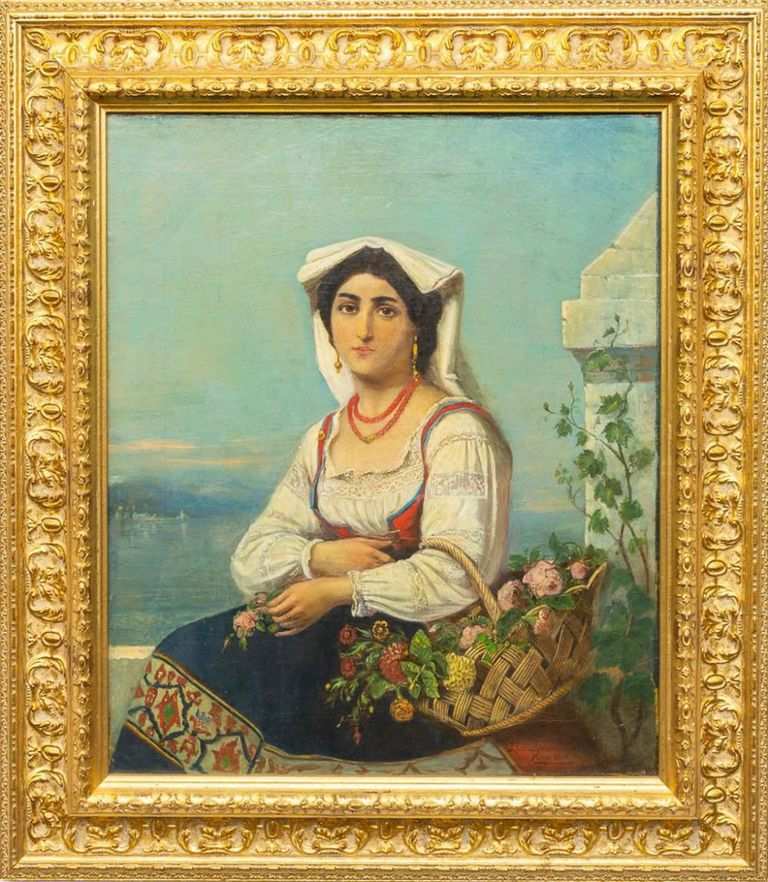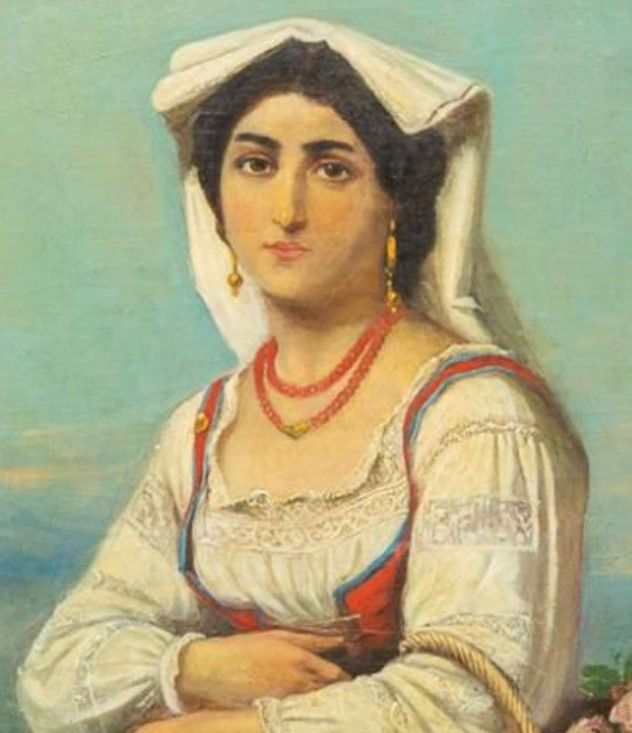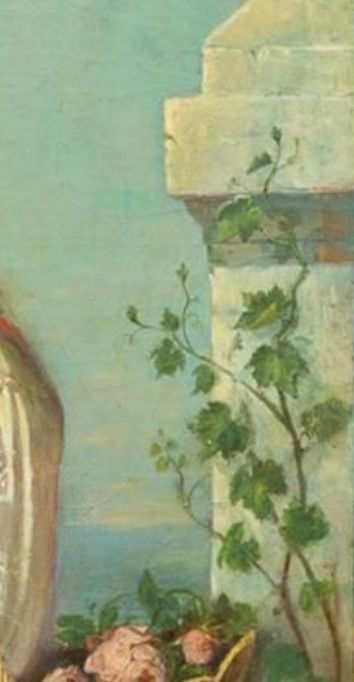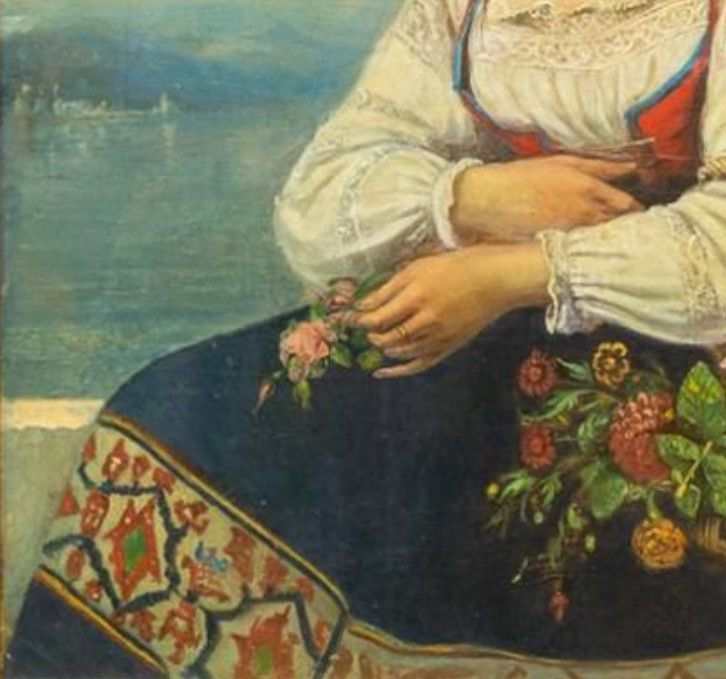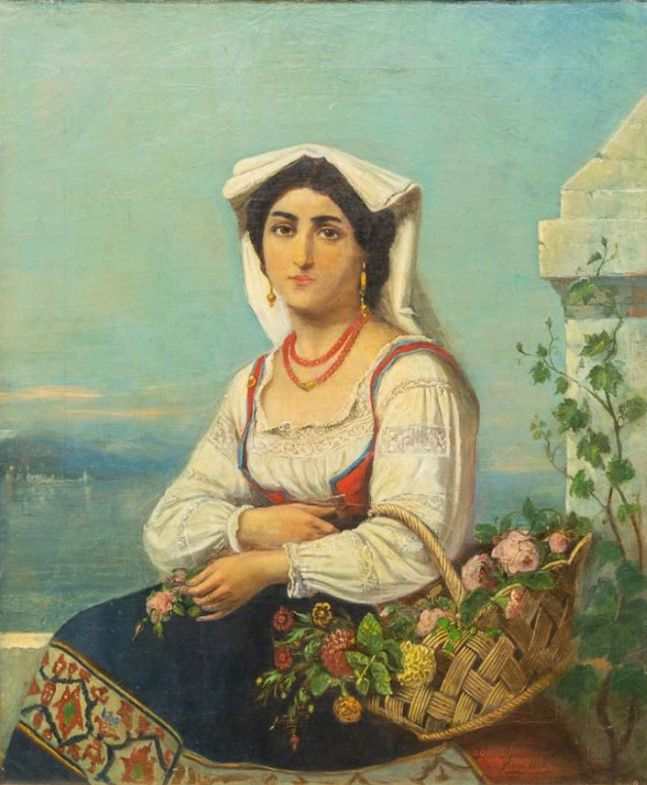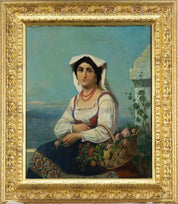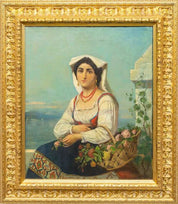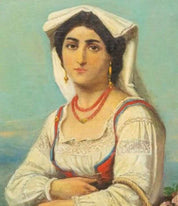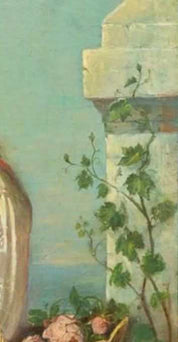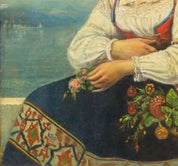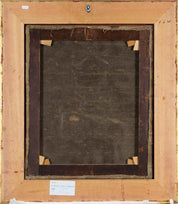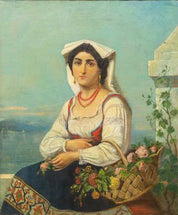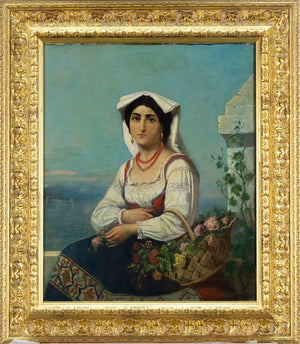Similar Items
Jan Jacobus Matthijs Damschröder, Portrait' 1866
$2,800.00 USD
Jan Jacobus Matthijs: "Portrait"
Jan Jacobus Matthijs captivating painting 'Portrait' presents a captivating glimpse into the 19th-century artistry that celebrated the beauty of portraiture. The artist's skillful use of composition and color harmoniously brings together a serene and detailed depiction of a seated woman within a charming Italian landscape.
Details:
Title: Portrait
Artist: Jan Jacobus Matthijs DAMSCHRÖDER
Date: 1866
Place: Rome
Medium: Oil on Canvas
Dimensions: 60.5 x 50.5 cm
Description:
In 'Portrait,' Jan Jacobus Matthijs DAMSCHRÖDER captures the essence of a moment frozen in time. The composition centers around a seated woman, elegantly dressed in a traditional Italian costume. The intricate details of her attire are a testament to Damschröder's meticulous artistry, highlighting his ability to render textures and fabrics with remarkable precision.
The woman's poised posture and calm demeanor exude a sense of serenity and introspection. Her direct gaze towards the viewer establishes a connection, inviting us to engage with her world. The delicate balance between the subject's tranquil expression and the vibrant energy of the surrounding landscape creates a captivating tension within the artwork.
The landscape, although intentionally vague, provides a complementary backdrop that enhances the prominence of the main subject. Damschröder's choice to keep the landscape soft and undefined allows the viewer to focus on the woman's presence and her connection with the natural world around her.
A basket filled with an array of colorful flowers rests on the woman's lap, adding a burst of vibrancy to the scene. The inclusion of a single rose in her hand serves as a symbol of beauty, love, and the ephemeral nature of life. This small yet poignant detail adds depth to the narrative and invites contemplation.
The painting's chromatic palette is a harmonious symphony of hues, seamlessly blending the vibrant colors of nature with the rich tones of the woman's attire. This integration of color enhances the overall visual experience, evoking a sense of delight and aesthetic pleasure.
Condition:
Fine craquelure in the paint layer, consistent with the item's age, is a testament to the passage of time and the historical significance of the artwork. Despite this natural aging, the painting remains in overall good condition, preserving its captivating allure.
Inscription:
The inscription 'Roma 1866' located in the lower right corner provides valuable historical context, indicating the place and year of the artwork's creation.
About the Artist:
Jan Jacobus Matthijs (1825-1905) is an artist whose contributions to 19th-century art are marked by a dedication to portraiture and narrative interiors. Born in Amsterdam, Damschröder specialized in painting scenes that captured the beauty of Dutch history and everyday life. His works often featured figures, particularly children, reflecting his ability to infuse his subjects with both realism and a sense of intimacy.
'Damschröder's legacy is rooted in his ability to bridge the gap between historical representation and personal connection. His expertise in portraying human emotions and moments is evident in 'Portrait,' a testament to his mastery of composition, color, and storytelling.
Jan Jacobus Matthijs captivating painting 'Portrait' presents a captivating glimpse into the 19th-century artistry that celebrated the beauty of portraiture. The artist's skillful use of composition and color harmoniously brings together a serene and detailed depiction of a seated woman within a charming Italian landscape.
Details:
Title: Portrait
Artist: Jan Jacobus Matthijs DAMSCHRÖDER
Date: 1866
Place: Rome
Medium: Oil on Canvas
Dimensions: 60.5 x 50.5 cm
Description:
In 'Portrait,' Jan Jacobus Matthijs DAMSCHRÖDER captures the essence of a moment frozen in time. The composition centers around a seated woman, elegantly dressed in a traditional Italian costume. The intricate details of her attire are a testament to Damschröder's meticulous artistry, highlighting his ability to render textures and fabrics with remarkable precision.
The woman's poised posture and calm demeanor exude a sense of serenity and introspection. Her direct gaze towards the viewer establishes a connection, inviting us to engage with her world. The delicate balance between the subject's tranquil expression and the vibrant energy of the surrounding landscape creates a captivating tension within the artwork.
The landscape, although intentionally vague, provides a complementary backdrop that enhances the prominence of the main subject. Damschröder's choice to keep the landscape soft and undefined allows the viewer to focus on the woman's presence and her connection with the natural world around her.
A basket filled with an array of colorful flowers rests on the woman's lap, adding a burst of vibrancy to the scene. The inclusion of a single rose in her hand serves as a symbol of beauty, love, and the ephemeral nature of life. This small yet poignant detail adds depth to the narrative and invites contemplation.
The painting's chromatic palette is a harmonious symphony of hues, seamlessly blending the vibrant colors of nature with the rich tones of the woman's attire. This integration of color enhances the overall visual experience, evoking a sense of delight and aesthetic pleasure.
Condition:
Fine craquelure in the paint layer, consistent with the item's age, is a testament to the passage of time and the historical significance of the artwork. Despite this natural aging, the painting remains in overall good condition, preserving its captivating allure.
Inscription:
The inscription 'Roma 1866' located in the lower right corner provides valuable historical context, indicating the place and year of the artwork's creation.
About the Artist:
Jan Jacobus Matthijs (1825-1905) is an artist whose contributions to 19th-century art are marked by a dedication to portraiture and narrative interiors. Born in Amsterdam, Damschröder specialized in painting scenes that captured the beauty of Dutch history and everyday life. His works often featured figures, particularly children, reflecting his ability to infuse his subjects with both realism and a sense of intimacy.
'Damschröder's legacy is rooted in his ability to bridge the gap between historical representation and personal connection. His expertise in portraying human emotions and moments is evident in 'Portrait,' a testament to his mastery of composition, color, and storytelling.
Popular Items
































